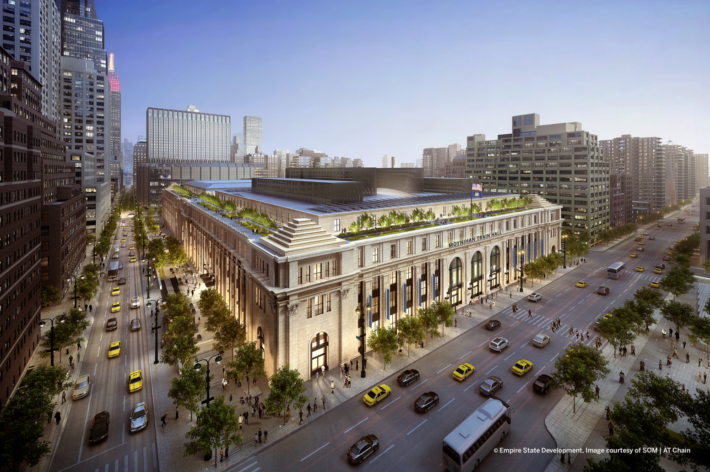
After much anticipation about the start date, construction began last month to turn the old post office building into an extension of Pennsylvania Station. The project is part of a plan to modernize the busiest train station in the United States and increase its total floor space by more than 50 percent.
New York Governor Andrew Cuomo announced at a press conference on August 17 the start of construction on the “state-of-the-art transit hub.” The James A. Farley Post Office, the 105-year-old, Beaux-Arts landmark building across the street from Penn Station on Eighth Avenue, will be redeveloped into a grand station with a modern glass roof. The train hall will be named the Moynihan Station in honor of the late Senator Daniel Patrick Moynihan, who first proposed the idea of the Penn-Farley Complex in the early 1990s.
“For decades, passengers were promised a world-class train hall worthy of New York,” said Governor Cuomo. “With better access to trains and subways, vibrant retail and business opportunities and stunning architectural design, we are bringing Penn Station into the 21st century.”
The new 1,000,000-square-foot train hall will serve Amtrak and Long Island Rail Road passengers. But the new complex will not expand train service, as the number of tracks will remain at 21. It will only provide more access points to the platforms.
Parts of the train station in the new complex have been operating for passenger service since June 15. The west concourse provides access to 17 of the 21 tracks used by LIRR and Amtrak trains. The new hall, once completed, will be above the train platforms, and passengers will be able to access all 21 tracks.
“Any improvements will make this better,” said Kyle Dougan, who took a train at Penn Station during Labor Day weekend. “It is too crowded and can be confusing sometimes,” he said, adding that the new annex in the post office looks nicer and cleaner than the existing station.
Ashley Sonson travels to Valley Stream on the LIRR. “Friday night’s commute to Long Island is hell so the multiple entrances will definitely help,” she said, adding, “I like the artwork on the wall,” of the new concourse. “It shows different parts of the city like Brooklyn and Queens, not just Manhattan.”
The new underground concourse has renderings of the future station on display. However, only a small fraction of the station will be used for train travel. The rest of the space will be for commercial and retail purposes.
According to Vornado Realty, which will jointly develop the station’s commercial space with Related companies under a 99-year lease, the 850,000 square-foot commercial space will have 730,000 square-feet of office space targeting “creative class tenants,” which include technology firms already located in Midtown West and 120,000 square-feet of retail space for shops and restaurants. A spokesperson for Vornado Realty said it was too soon at this stage to specify the names of the tenants.
Both companies, which have agreed to contribute $630 million towards the $1.6 billion-dollar construction cost, already have several projects around the area. Vornado Realty is the largest property owner around Penn Station with nine million square feet of commercial space inside Penn Plaza. And Related is developing several high-end residential and commercial properties at nearby Hudson Yards.
“The real estate around Penn Station will definitely rise in value,” said Matthew Bank of DG Neary Realty. With the Hudson Yards development and the 34th Street-Hudson Yards subway station, Bank said the interest in that area has been rising and the Moynihan Station will only add to the demand. “Penn Station is a grim portal to the city. It is oppressive and ugly,” he said. “So I am very excited about this project.”
Not everyone shares his excitement. Zachary Zheng, a restaurant worker at a Japanese eatery near the Farley Building, said he is concerned the construction will cause traffic. “The business will be bad during the construction because of the road block. But it will be great after it completes as the station will bring in more people,” he said.
Although the new Moynihan train hall is not due for completion until the end of 2020, Penn Station has returned to its regular operation. Amtrak trains resumed their normal schedule on September 5, officially ending the “Summer of Hell,” in which track repairs diverted several trains to other terminals affecting thousands of commuters.
“It will be great if the new station opens in time but I think it will be delayed,” said Caryn Bernstein, who takes the train from Penn Station to Bayside, Queens. “I hate Penn Station. It’s overcrowded and it’s old. The new station will be a slight improvement.”